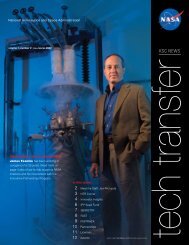2006-2007 - Kennedy Space Center Technology Transfer Office
2006-2007 - Kennedy Space Center Technology Transfer Office
2006-2007 - Kennedy Space Center Technology Transfer Office
- No tags were found...
You also want an ePaper? Increase the reach of your titles
YUMPU automatically turns print PDFs into web optimized ePapers that Google loves.
Nanosensors for Evaluating Hazardous EnvironmentsHazardous-LeakDetection andIsolationPersonnel working in a confined environment can be exposed to hazardous gases, andcertain gases can be extremely dangerous even in concentrations as low as a few parts perbillion.Nanosensors can be placed in multiple locations over a large area, thus allowing for more preciseand timely detection of gas leaks. ASRC Aerospace and its research partners are developing nanosensorsto detect various gases, including hydrogen, ammonia, nitrogen tetroxide, and hydrazine.Initial laboratory testing demonstrated the capability to detect these gases in concentrations lowerthan parts per million, and current testing is evaluating sensitivity at concentration levels threeorders of magnitude lower. Testing and development continue to improve the response and recoverytimes and to increase the sensitivity of the devices. The development team is evaluating differentcoatings and electrodes to determine the optimum configuration for detecting and identifyinga variety of gases.The small footprint of the nanosensors allows several devices to be placed into a single substrate.Each sensor is responsive in a different way to different gases. Embedding multiple devices into asingle substrate results in better reliability and less frequent calibrations. The use of different coatingsfor individual elements of a multichannel sensor allows different gases to be identified. Thesensor system is implemented by the use of a custom multichannel signal conditioner amplifierbuilt on a small multichip module. This device processes the output of the sensors and transmits asignal that can be monitored and analyzed remotely. All the data is digitized and transmitted overthe same cable pair used to power the amplifier. Connecting multiple outputs to a single cable pairwill reduce the weight and expense associated with cabling in a spacecraft.Although the initial work concentrated on the detection of nitrogen dioxide and nitrogen tetroxide,sensors are being developed and tested for detection of hydrogen, ammonia, hypergolic fuel(hydrazine), hypergolic oxidizer (nitrogen tetroxide, which is analyzed as nitrogen dioxide), andmonomethylhydrazine. The sensors are being evaluated under a wide variety of environmentalconditions, including various temperatures, humidities, and gas concentrations. The initial testevaluates the sensor’s ability to identify and analyze three concentrations of hydrazine at constanttemperature and humidity. The final objectives will be to optimize individual responses to variousgases and to integrate the sensors onto a single substrate.Monitoring of the environment is not limited to the detection of gas leaks, and monitoring willbecome increasingly important as longer-duration space missions are planned and executed. Awide array of nanosensors needs to be developed and qualified for space flight under realistic operatingconditions, and this activity will continue for years to come.Contact: Dr. Pedro J. Medelius , ASRC Aerospace, (321) 867-6335Participating Organizations: ASRC Aerospace (Dr. Tracy L. Gibson and Dr. Barry J. Meneghelli), NASA-KSC(Michael E. Vinje and Jose M. Perotti), and NASA Ames Research <strong>Center</strong> (Dr. Jing Li)110 Command, Control, and Monitoring Technologies













